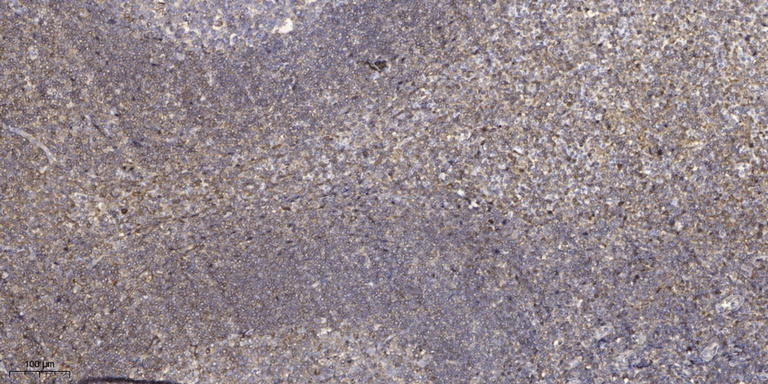- 首页
- 公司介绍
- 热门促销
-
全部产品
-
试剂盒
- |
-
一抗
- |
-
二抗
- |
-
蛋白
- |
-
免疫组化试剂
- |
-
WB 试剂
- PonceauS Staining Solution
- PBST Washing Buffer, 10X
- 1.5M Tris-HCl Buffer, pH8.8
- 1M Tris-HCl Buffer, pH6.8
- 10% SDS Solution
- Prestained Protein Marker
- TBST Washing Buffer, 10X
- SDS PAGE Loading Buffer, 5X
- Stripping Buffered Solution
- Tris Buffer, pH7.4, 10X
- Total Protein Extraction Kit
- Running Buffer, 10X
- Transfer Buffer, 10X
- 30% Acr-Bis(29:1) Solution
- Tris电泳液速溶颗粒
- PBS(1X, premixed powder)
- TBS(1X, premixed powder)
- 快速封闭液
- 转膜液速溶颗粒
- Chemical reagents
- 公司新闻
- 营销网络
- 资源中心
- 联系我们
TGR5 Polyclonal Antibody
- 货号:YT4636
- 应用:WB;ELISA;IHC
- 种属:Human;Rat;Mouse;
- 蛋白名称:
- G-protein coupled bile acid receptor 1
- 免疫原:
- The antiserum was produced against synthesized peptide derived from human GPBAR. AA range:11-60
- 特异性:
- TGR5 Polyclonal Antibody detects endogenous levels of TGR5 protein.
- 组成:
- Liquid in PBS containing 50% glycerol, 0.5% BSA and 0.02% sodium azide.
- 来源:
- Polyclonal, Rabbit,IgG
- 稀释:
- WB 1:500-2000;IHC 1:50-300; ELISA 2000-20000
- 纯化工艺:
- The antibody was affinity-purified from rabbit antiserum by affinity-chromatography using epitope-specific immunogen.
- 储存:
- -15°C to -25°C/1 year(Do not lower than -25°C)
- 其他名称:
- GPBAR1;TGR5;G-protein coupled bile acid receptor 1;G-protein coupled receptor GPCR19;hGPCR19;Membrane-type receptor for bile acids;M-BAR;hBG37;BG37
- 背景:
- This gene encodes a member of the G protein-coupled receptor (GPCR) superfamily. This enzyme functions as a cell surface receptor for bile acids. Treatment of cells expressing this GPCR with bile acids induces the production of intracellular cAMP, activation of a MAP kinase signaling pathway, and internalization of the receptor. The receptor is implicated in the suppression of macrophage functions and regulation of energy homeostasis by bile acids. Alternative splicing results in multiple transcript variants encoding the same protein. [provided by RefSeq, Jul 2008],
- 功能:
- function:Receptor for bile acid. Bile acid-binding induces its internalization, activation of extracellular signal-regulated kinase and intracellular cAMP production. May be involved in the suppression of macrophage functions by bile acids.,similarity:Belongs to the G-protein coupled receptor 1 family.,tissue specificity:Ubiquitously expressed. Expressed at higher level in spleen and placenta. Expressed at lower level in other tissues. In digestive tissues, it is expressed in stomach, duodenum, ileocecum, ileum, jejunum, ascending colon, transverse colon, descending colon, cecum and liver, but not in esophagus and rectum.,
- 细胞定位:
- Cell membrane ; Multi-pass membrane protein .
- 组织表达:
- Ubiquitously expressed. Expressed at higher level in spleen and placenta. Expressed at lower level in other tissues. In digestive tissues, it is expressed in stomach, duodenum, ileocecum, ileum, jejunum, ascending colon, transverse colon, descending colon, cecum and liver, but not in esophagus and rectum.

- Immunofluorescence analysis of LOVO cells, using GPBAR Antibody. The picture on the right is blocked with the synthesized peptide.

- Immunohistochemical analysis of paraffin-embedded human tonsil. 1, Antibody was diluted at 1:200(4° overnight). 2, Tris-EDTA,pH9.0 was used for antigen retrieval. 3,Secondary antibody was diluted at 1:200(room temperature, 45min).





